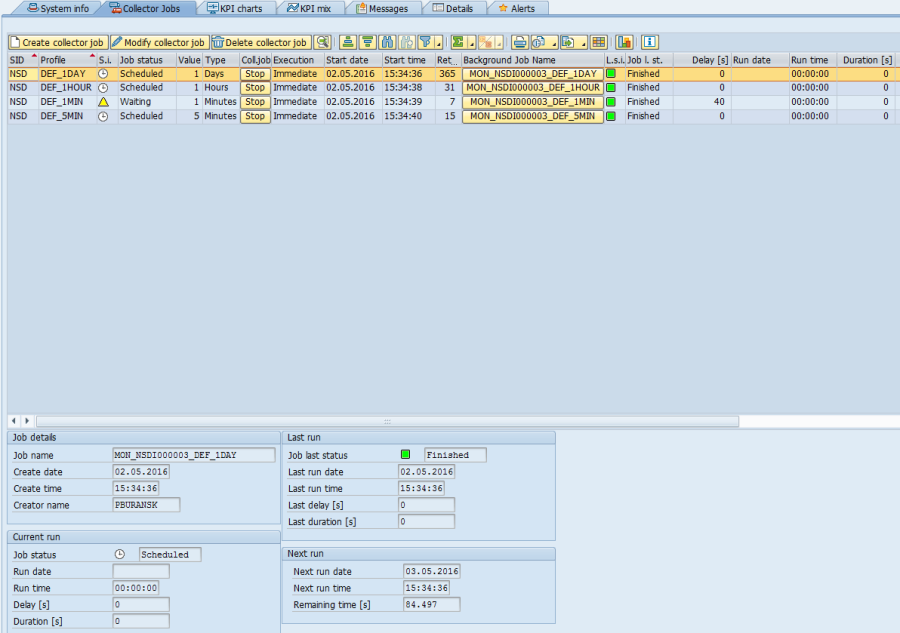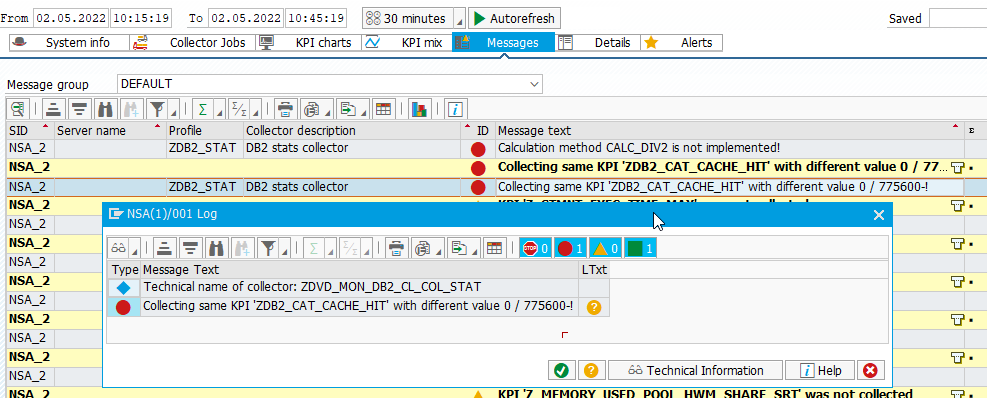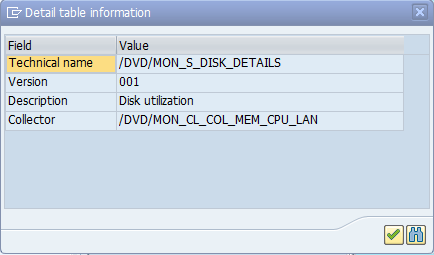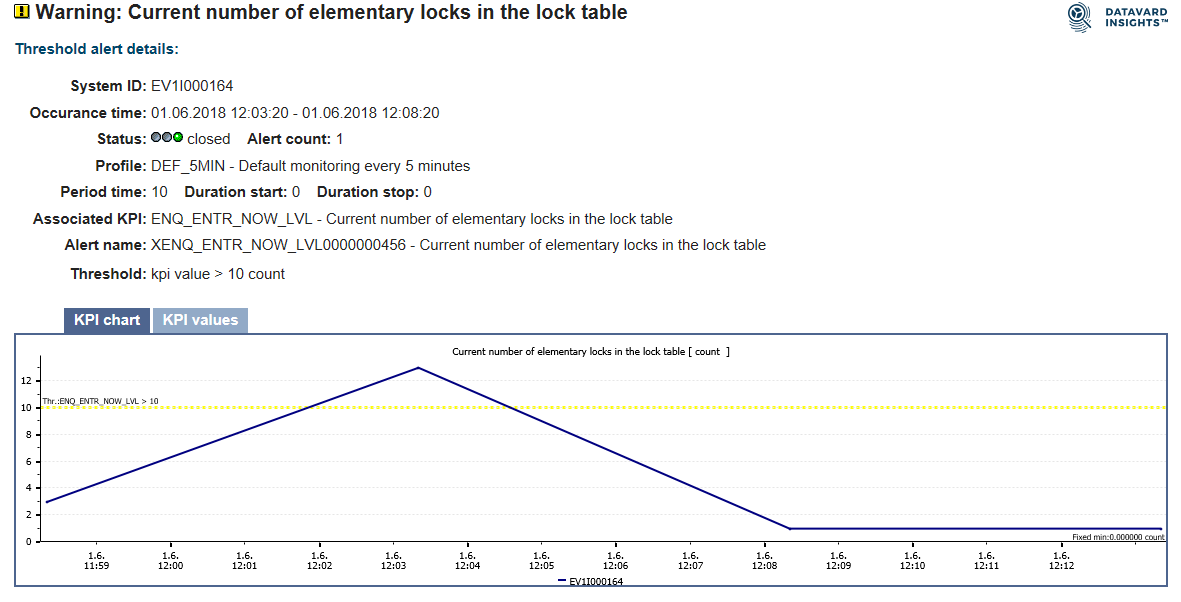(DI-2205) Working Tabs
This chapter describes briefly, what information you can find under the individual tabs on the main screen.
System info
In this tab following information about all monitored systems is displayed:
- basic information is in Monitored system.
- Information about the hardware configuration of the hosted machine is in Host data.
- Information about the database in the Database data.
- Information about the connection to a monitored system in the Connection data.
- Information about defined (DI-2205) System Settings Maintenance for system. The user might modify the server type in External server types view (redirection by button).
At the bottom of this tab is displayed a list of servers. This list provides an overview of servers, their names, the type of the server (application or database), hostname, the number of the CPU(s), RAM size, server location, and description.
If the number of CPU(s) and RAM size is equal to 0 for the specific server, it means that this server has no free resources. If this specific server has negative values set for CPU count or RAM size [kB] in (DI-2205) System Settings Maintenance, this server had no free aRFC resources for its monitoring.
If there is a flag in the field Don't mon., then the server is excluded from monitoring.
Detailed system information with a list of servers
Collector jobs
Collector jobs displays all Collector jobs for monitored systems and provides information regarding their statuses. From this tab, you may control and check the Collector job runs.
For more information about the functionality, see the chapter (DI-2205) Schedule the Monitoring of KPIs.
In the list of Collector jobs, the following information is displayed:
- SID – System ID for which a Collector job has been created.
- Profile – Monitoring profile of a KPI assigned to the Collector job. For more information, see the chapter (DI-2205) Define a Monitoring Profile for a KPI.
- Status icon and Job status – Status of a Collector job. The Collector job can have the following statuses:
- Not running – Not scheduled Collector job
- Scheduled – Collector job is scheduled for periodical runs in the future
- Waiting – Collector job is waiting for free work processes
- Running - Collector job is currently running
- Period value / Period type – how often a Collector job is running.
- Collector job run
- – Stops and cancels the scheduled Collector job, if the Collector job is running.
– Starts the Collector job if the Collector job isn't running.
If any collector job is in a suspended state (e.g. suspended by SAP standard functionality before any system activities), it is not possible to start or stop the job and the following message is raised "It is not allowed to &1 suspended jobs for system '&2' and profile '&3'". In this scenario, the suspended job must be handled manually by your basis team into an unsuspended state before starting the collector job again.
- Execution – The execution of a Collector job may be immediate or scheduled on a specific date and time.
- Start date/Start time – Date and time of the initial run of a Collector job.
- Retention time(days) – How long old collected data is stored by the Collector job. Data older than retention time is automatically deleted with the exception of data, which is excluded from deletion, see the chapter (DI-2205) Store Data Defined Through a Time Interval.
- Background Job Name – Name of the background job of the Collector job. Clicking on this button executes the transaction SE37 which displays this job.
- Last status icon and Job last status – Status of the last job run. The following statuses are possible:
- Finished – The last background job of a Collector job finished successfully
- Aborted – The last background job of a Collector job terminates due to an error or is canceled by the user
- Not running – The Collector job wasn't started
- Delay[s] – Any delay of current background job in seconds while waiting for a free work process.
- Run date/Run time – Date and time of the current background job execution.
- Duration – How long has the current background job been running.
Collector jobs
- Last delay – Delay of the last background job in seconds when it waited for a free work process.
- Last run date/Last run time – Date and time when the last background job has been started.
- Last duration – How long the last background job of a Collector job was running.
- Remaining time – Time in seconds after which the next run of a Collector job will occur.
- Next run date/Next run time – Date and time of the next Collector job run.
- Create date/Create time – Date and time of a background job creation of a Collector job.
- Creator name – The user who started/stopped the background job of a Collector job.
If you double click on the Collector job record in the list, then all information is displayed in detail at the bottom section.
In the top bar, the menu of a Collector job list is available which contains all standard buttons for working with the ALV list and which allows you to sort, filter, etc.
In addition, a Refresh button is available along with the information about the last time of a refresh.
KPI charts
All collected KPIs of monitored systems are represented in the form of charts within this tab.
In these charts, you can view the behavior of monitored KPIs with respect to the time and systems you specified. Each chart describes one measured KPI in a selected time interval for systems and servers that have been selected in System landscape.
In the context menu of a KPI chart area, a KPI context menu is displayed. You can find a description of all available functions of the context menu in the chapter (DI-2205) KPI Tree and Context Menu.
For more information on how to display KPIs, see the chapter (DI-2205) Display KPIs.
KPI mix
By using the KPI mix tab, you can display several KPI series in one chart and compare dependencies between all measured and displayed KPIs in this chart. For more information about the KPI mix chart, see the chapter (DI-2205) Display Several KPIs in KPI Mix Chart.
Messages
The Messages tab displays the status of messages identified by CrystalBridge® Monitoring (for example, during the collection of KPIs for the monitored system). Each message contains a text description with some additional information (when it occurred, on which system/server, and type of the message).
There are three standard types of messages:
- - OK / successful messages
- - Information / alert messages
- - Error messages
Displayed messages are dependent on the selected systems or servers in System landscape. In this tab, you might use standard ALV operations such as sorting, filtering, aggregating, etc.
If the user double-clicks the row for the occurred message, the technical name of the collector is displayed with the occurred message in the following pop-up window.
For SQL-based KPIs which are collected by SQL collector, in case of any failures occurred during its SQL execution, the additional details are displayed in this pop-up window (e.g., SQL code error, the text of failure, and the full string of executed SQL statement.
At the top of the Messages tab is a list box based on which you can filter displayed messages. This list box represents the available (DI-2205) Message Groups. You can find technical details of the message in its long description by double-clicking on the message row and the long description button. The relevant message ID and number need to be specified in the chapter (DI-2205) Message Groups.
Technical Message groups
There are two message groups that are not available in the customizing and are not modifiable.
DEFAULT
By default, this message group is selected when the application has started. This view displays all messages except the excluded ones. You can specify a list of messages to be excluded in (DI-2205) Message Groups message group
All messages (with excluded)
This group displays all messages also with the excluded ones.
Details
This tab contains additional KPI information collected from the monitored systems and stored in a Detail table. It displays a list of collected detail tables by default (you can adjust a setting to display all available detail tables with the not collected ones in (DI-2205) User Display Settings). You might search and filter over this list by technical name or by displayed description for a detail table. Next to the list of detail tables, there are displayed collected details for a KPI. Over these details is possible to perform all standard ALV operations like sorting, filtering, aggregating, etc.
Detailed KPI information from monitoring
You can also find some technical information about a detail table by clicking the icon .
More information can be found in the chapter (DI-2205) KPI Details Displayed in a Detail Table.
Alerts
Alerts display messages during monitoring and collecting of KPIs, where an event occurs to one or more specific KPIs' values. Listed below are some examples of events when an alert occurs:
- Massive short dumps within a short period of time
- System downtime or unavailability
- System stops/restarts
- A typical peaks or downs in system performance
- Start/end of SLO operations (conversions or migrations)
- Users working in the system during conversions and many others
Such an events occur as long as the corresponding KPI values are outside of the threshold limit. If events last for a long time, then the alerts keep informing you that such events are still occurring and enable you to keep track and monitor the event's progress.
More information can be found in the chapter (DI-2205) Alert Definition
Through an event occurrence, the process is recorded and stored within the Alerts tab. There, you can find an ALV list of occurred events. Each line of the list represents one event. It has information about the system and the server (if the KPI of the event is server-specific).
The type of alert informs you about the alert status as follows:
- - Success event
- - Warning event
- - Issues event
- - Error event
Count displays the number of occurred event alerts. Other information displayed here is – when an event has started and when it has ended (if it has ended), the event's description, etc.
Occurred events
With this ALV list of messages, it is possible to perform all standard ALV operations like sorting, filtering, aggregating, etc.
For a more detailed view of an event, just double-click on a line.
Detail output





























